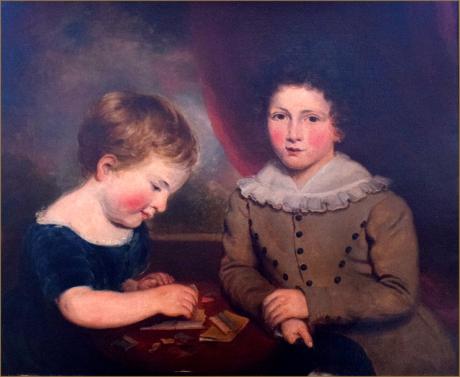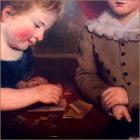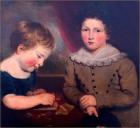The Puzzle that the two boys are playing with is a geographical puzzle. However to the left there is an interlocking piece, and according to Linda Hannas “The English Jigsaw Puzzle, 1760 to 1890”, Wayland Publishers, London, 1972; interlocking border pieces (very useful) are a somewhat later invention, c. 1785. and that’s the time that explanatory books came with the didactical puzzles when they were sold. Such a booklet is depicted in the portrait.
A jigsaw puzzle is a tiling puzzle that requires the assembly of often oddly shaped interlocking and tessellating pieces. Each piece usually has a small part of a picture on it; when complete, a jigsaw puzzle produces a complete picture. In some cases, more advanced types have appeared on the market, such as spherical jigsaws and puzzles showing optical illusions.
Jigsaw puzzles were originally created by painting a picture on a flat, rectangular piece of wood, and then cutting that picture into small pieces with a jigsaw, hence the name. John Spilsbury, a London cartographer and engraver, is credited with commercializing jigsaw puzzles around 1760. Jigsaw puzzles have since come to be made primarily of cardboard.
Typical images found on jigsaw puzzles include scenes from nature, buildings, and repetitive designs. Castles and mountains are two traditional subjects. However, any kind of picture can be used to make a jigsaw puzzle; some companies offer to turn personal photographs into puzzles. Completed puzzles can also be attached to a backing with adhesive to be used as artwork.
During recent years, a range of jigsaw puzzle accessories including boards, cases, frames, and roll-up mats has become available that are designed to assist jigsaw puzzle enthusiasts. The engraver and cartographer John Spilsbury, of London, is believed to have produced the first jigsaw puzzle around 1760, using a marquetry saw. Early jigsaws, known as dissections, were produced by mounting maps on sheets of hardwood and cutting along national boundaries, creating a puzzle useful for the teaching of geography. Such "dissected maps" were used to teach the children of King George III and Queen Charlotte by royal governess Lady Charlotte Finch. The end product was an educational pastime, designed as an aid in teach British children their geography. The idea caught on and, until about 1820, jigsaw puzzles remained primarily educational tools.
Vermeer Jigsaw Puzzle, from PiatnikIn 1880, with the introduction of the treadle saw, what had previously been known as dissections (not a word with particularly enjoyable connotations in our own time) came to be known as jigsaw puzzles, although they were actually cut by a fretsaw, not a true jigsaw. Towards the end of the century plywood came to be used. With illustrations glued or painted on the front of the wood, pencil tracings of where to cut were made on the back. These pencil tracings can still be found on some of these older puzzles.
Cardboard puzzles were first introduced in the late 1800's, and were primarily used for children's puzzles. It was not until the 20th century that cardboard puzzles came to be die-cut, a process whereby thin strips of metal with sharpened edges - rather like a giant cookie-cutter - are twisted into intricate patterns and fastened to a plate. The "die" (which refers to this assembly of twisted metal on the plate) is placed in a press, which is pressed down on the cardboard to make the cut.
The name "jigsaw" came to be associated with the puzzle around 1880 when fretsaws became the tool of choice for cutting the shapes. Since fretsaws are distinct from jigsaws, the name appears to be a misnomer. Cardboard jigsaw puzzles appeared during the late 1800s, but were slow to replace the wooden jigsaw due to the manufacturer's belief that cardboard puzzles would be perceived as being of low quality, and the fact that profit margins on wooden jigsaws were larger.
Jigsaw puzzles soared in popularity during the Great Depression, as they provided a cheap, long-lasting, recyclable form of entertainment. It was around this time that jigsaws evolved to become more complex and more appealing to adults. They were also given away in product promotions, and used in advertising, with customers completing an image of the product being promoted.
Sales of wooden jigsaw puzzles fell after World War II as improved wages led to price increases, while at the same time improvements in manufacturing processes made cardboard jigsaws more attractive. According to the Alzheimer Society of Canada, doing jigsaw puzzles is one of many activities that can help keep the brain active and may contribute to reducing the risk of developing Alzheimer's disease.
John Russell, (1745–1806), portrait painter and astronomer, was born on 29 March 1745 at 32 High Street, Guildford, the second child of John Russell (1711–1804), book- and printseller, five times mayor of Guildford, and an artist himself (his Prospects of Guildford were engraved and published in 1759 and 1782), and his wife, Ann Parvish (1719–1775).
John Russell was baptized in the ruins of Holy Trinity Church, Guildford, and educated at the local grammar school before winning premiums at the Society of Arts in 1759 and 1760. He was then apprenticed to the painter Francis Cotes, who became a friend and mentor, and painted a miniature of his promising pupil. This happy relationship was frequently endangered by Russell's religious ‘conversion’, which began with an entry on the title-page of his diary, decorated with a stony desert and a view of Golgotha in the background: 'John Russell converted September 30, 1764, aetat. 19, at about half an hour after seven in the evening' (Russell). This prompted an evangelical ardour. For example, while painting Lord Montagu's portrait at Cowdray House in 1767, Russell not only annoyed the household by his intrusive fanaticism but excited such ill feeling among the many Anglicans and Roman Catholics of the neighbourhood that on his return journey he was refused accommodation at all the inns in Midhurst. Even his fellow citizens of Guildford rioted in protest.
In 1768 Russell settled in London, first in Portland Street, where he painted, in 1769, an oil portrait of the notorious forger Dr William Dodd (NPG). Here he met another celebrated Methodist, Selina Hastings, countess of Huntingdon, who tried unsuccessfully to make him give up painting and to lure him to her religious community. On 5 February 1770 he married one of his ‘converts’—Hannah Faden (1745–1816), daughter of a map- and printseller at Charing Cross—and moved to 7 Mortimer Street, Cavendish Square. They lived contentedly there, moving later to Newman Street, and produced twelve children, their religious enthusiasm gradually subsiding.
At about this time Russell turned from oils to pastel, a medium in which he excelled, forming his style on that of Rosalba Carriera. A stream of portraits followed, exhibited first at the Incorporated Society of Artists, then in 1769 at the first exhibition of the Royal Academy, where he continued to show annually until his death in 1806. His pastel portraits are technically and aesthetically brilliant, easily surpassing those of his master, Francis Cotes. They are usually laid on blue paper, the pastel colours vivid, a striking sfumato effect achieved by blurring with the finger and crayon, and the details accented with black chalk. In 1770 he showed his Portrait of George Whitefield and his large figure Aquarius won the Royal Academy's gold medal. He also painted the eleven-year-old William Wilberforce (the work is in the National Portrait Gallery, London), the first of many oil and pastel portraits of the philanthropist who later described Russell as 'A religious man, very high-church indeed.' (R. I. Wilberforce and S. Wilberforce, The Life of William Wilberforce, vol. 1, 1838, 5–6). Marriage may have softened Russell's militant evangelicalism but his diary bears daily witness to anxiety for his spiritual welfare. He would not work on a Sunday nor would he allow anyone to enter his studio. He was afraid to go out to dinner on account of the loose and blasphemous conversation he might hear. He was on good terms with Sir Joshua Reynolds, with whom he dined at the Royal Academy, the Dilettanti Society, and the Literary Club, but on these and other festive occasions he always left early.
Dozens of fancy pictures followed, specially of children with dogs, cats, foxes, squirrels, rabbits, and owls. One of these, Girl with Cherries (1781), is in the Louvre, and two others, Fortune-Teller and Girl with Cat (1790 and 1791), are in the Tate Collection. Russell produced hundreds of portraits, many exhibited at the Royal Academy, beginning with three or four a year, and working up to seventeen in 1789 and twenty-one in 1790. One oil, Charles Wesley (1771), hangs in Wesley's house in Bristol (collection of the Museum of Methodism, London); his Countess of Huntingdon (1772) was lost in a shipwreck on a voyage to Georgia or destroyed in a fire at Huntingdon's Georgia orphanage, and another, John Wesley (1773), was also lost; both survive in engravings (Bethesda Boys' Home, Savannah, Georgia, and Kingswood School, Bath, respectively). From 1781 he tried his hand at painting miniatures, exhibiting nine in the next five years. They are scarce and painted in watercolour or gouache on ivory with broad sweeping strokes of the brush. One of George IV when prince of Wales, is a miniature variant of a pastel in the Fogg Art Museum, Harvard University, which in turn is closely related to his full-length oil of the prince in the uniform of the royal Kentish bowmen, in the Royal Collection. Another is at Corsham Court and two, attributed to Russell, are at Petworth House.
In 1788 Russell was elected a Royal Academician and in the following year, as a result of his portraits of the king's physician, Dr Willis, and Queen Charlotte and her family, he was appointed painter to the king and the prince of Wales, also to the duke of York. In 1796 he painted the princess of Wales with the little Princess Charlotte on her knee, seen in Russell's house by Joseph Farington, who described 'the manner of the Princess as very affable, witht. the least of German hauteur' (Farington, Diary, 11 Nov 1796). His large pastels (91 × 71 cm) of the two famous bathing attendants at Brighton, John ‘Smoaker’ Miles and Martha Gunn, were commissioned by the prince of Wales, and both are still in the Royal Collection.
Royal patronage and his own prolific output assured Russell relative affluence. A small freehold estate in Dorking was left him in 1781 by a cousin. His diary records an income of £600 in 1786 and £1000 in 1789, 'and probably on the increase'. He appears to have been well employed as long as he lived, charging about the same high prices as Sir Joshua Reynolds, but he never became a fashionable artist; most of his sitters were connected with the throne, the pulpit, or the stage where, curiously enough, he had many friends. In the latter part of his life he spent much of his time in Yorkshire, specially at Leeds, where he also had many friends and painted some of his best works. Among his pastel portraits, interesting for their subjects, are: Philip Stanhope, son and recipient of Lord Chesterfield's letters; John Bacon, the sculptor and an intimate friend; Bartolozzi, the engraver; William Cowper, the poet; William Wilberforce, the philanthropist; Admiral Bligh of the Bounty; Mrs Jordan, Mrs Siddons, and Jack and Elizabeth Bannister of the stage; and Richard Brinsley Sheridan (NPG).
In 1772 Russell published his excellent and detailed Elements of Painting with Crayons, purporting to explain the technique of Francis Cotes but in fact a handbook to the art of pastel painting. He revised and enlarged it in 1777, and it became popular throughout the nineteenth century. He recommended a strong blue paper, the thicker the better and mounted on linen. The posture he advised was 'sitting with the box of crayons in his lap'. The smudging or sfumato effect he described as 'sweetening with the finger'. He made his own crayons, mixing the colours with spirits of wine on a grindstone, then rolling them quickly 'into pastils in the left hand with the ball of the right, first forming them cylindrically and then tapering them at each end' (Williamson, 93–4).
Between 1797 and 1807 Dr Robert John Thornton published The New Illustration of the Sexual System of Linnaeus, a great work which included The Temple of Flora, illustrated by Philip Reinagle and others. Russell made the frontispiece, and also pastel portraits of Thornton himself (exh. RA, 1799), Mrs Thornton, and other botanists, including Sir James Edward Smith, founder of the Linnean Society (oil), and Dr A. B. Lambert, both in the society's collection in Piccadilly, London.
Russell was also an astronomer: about 1784 he was introduced to Sir William Herschel, whose portrait, holding a diagram of the Georgian planet (Uranus) and its satellites, he painted in 1794 (Science Museum, London). Another sitter was the astronomer royal, Nevil Maskelyne (1804), and several fellows of the Royal Society, including William Hey, Thomas Martyn, and George Keate. His portrait of Dr John Jeffries (NMM) shows the American loyalist crossing the English Channel, with the French astronaut Jean-Pierre Blanchard in an air balloon equipped with scientific instruments. But his interest in astronomy began long before when, as a young man, he was struck by the beauty of the moon seen through a telescope belonging to a friend, the sculptor John Bacon. This developed into serious lunar studies which produced the largest and most accurate picture of the moon to date, a mechanical moon bearing an engraved lunar map (the selenograph), a relief map of the moon, and an engraving of the full moon maps, the lunar plenispheres. In his portrait Sir Joseph Banks (oil), the president of the Royal Society is shown holding one of the moon maps. An album in the Museum of the History of Science, Oxford, contains working drawings, with the first sketch labelled: 'Drawn about the Year 1764. This is the first drawing I ever made from the Moon. J. R. in the Garden of John Bacon RA, 17 Newman Street' (Russell's drawings, fol. 1, appx 3). Joseph Farington took tea with Russell in 1793,
and was highly gratified by seeing the different representations he has made of the appearance of the Moon—he told us he had been about 7 years engaged in this undertaking … He described to us the manifest errors which have been given by others. That of Cassini is very incorrect.
Russell's diary, kept in the Victoria and Albert Museum Library, was written in the Byrom shorthand system, and deciphered and indexed by his grandson, the Revd S. H. Russell, in 1871. A specimen page is illustrated in Williamson (p. 96). It begins with his conversion on 30 September 1764 and ends on 4 January 1801. In December 1800 Russell injured himself by a fall through a broken cellar-flap, and early in 1801 he caught his finger in a steel trap which prevented his working for some weeks. In 1803 he became deaf after an attack of cholera, but he was none the less able to produce what was his largest pastel picture, Lady Johnstone and her Family and a Greyhound (185 × 140 cm; priv. coll., Yorkshire). In 1805 he complained of 'having the stone' (Farington, Diary, 14 April 1806). Early in 1806 he went to Hull where he was visited by the poet Kirk White who earlier had described him as 'a complete artist … inclined to Hutchinsonian principles' (White to B. Maddock, 31 Jan 1805, Williamson, 83). He died there of typhus on 20 April 1806 and was buried under the choir stalls of Holy Trinity, Hull.
His third son, William Russell (1784–1870), born on 26 November 1784, who was with him when he died, exhibited pastels at the Royal Academy and the British Institution from 1805 to 1809, and the oil portraits Lord Erskine (exh. RA, 1808) and Judge Bailey (NPG). He was educated at the Revd George Gibson's school, London. He was ordained on 21 May 1809, giving up painting for fear it might interfere with his spiritual duties, and became, for forty years, rector of St Nicholas, Shepperton, Middlesex. He married Laetitia Ann Nichols. He died on 14 September 1870 at 5 The Grove, Highgate, Middlesex.
R. J. B. Walker DNB.



